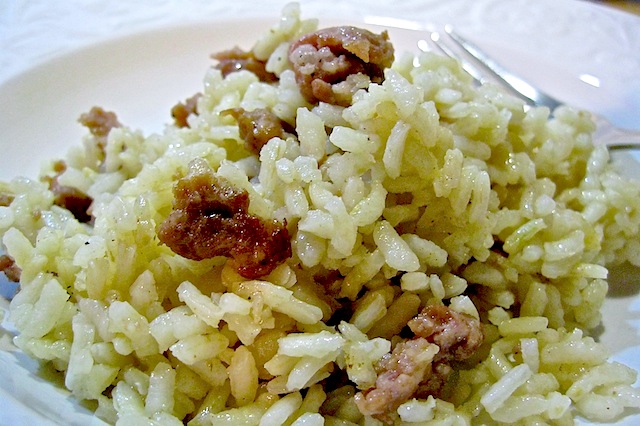A traditional dish, it owes its name to those working at "pilatura" or refining process of the rice, called in fact "piloti" (from "pila", the large mortar where the rice was separated from the glume using a sort of mechanical, hand operated pestle), who were specialists in preparing this dish and, given the large appetite created by the manual work, usually put lots of condiment into this risotto, doubling the doses of butter, salame and grana cheese given in the current version.
Difficulty: Medium
Preparation time: 45 minutes
Cooking technique: Boiling
Season: All year round
Equipment: Heavy bottomed pan with lid, sheet of paper, cloth, frying pan, fork
Preparation for 4 portions:
• VIALONE CIMA RICE: 400 g
• SMALL MANTUA SALAMI: 140 g
• GRATED GRANA CHEESE: 70 g
• BUTTER: 70 g
• SALT: to taste
The ingredient: salamella
This is a kind of salami that must be cooked, typical of the Mantua area, but widespread throughout the whole of Lombardy.
Salamella is made using a mixture of meat taken from the shoulder, much leaner than that normally used for preparing cotechino and cooking salami, and flavoured just with salt and pepper.
Given the simplicity of its ingredients and the reduced quantity of fat in this stuffed meat, you can also eat its stock, in the same way as in the Cremona area with pan salami, giving a stock that can be used as an ingredient in the "three stocks" of marubini pasta.
• Pour 850 ml of slightly salted water into a heavy based saucepan;
• put on the heat;
• bring to the boil and pour in the rice from a cone of paper so that it all falls into the centre of the pan, forming a conical mountain with its tip about 1cm above the level of the water (if the water covers the tip, remove some water with a ladle);
• when it starts to boil again, gently shake the pan so that the rice falls down a little and continue to cook over a high heat for about 12 minutes;
• remove the pan from the heat, cover and wrap in a thick cloth to keep it warm and leave to rest for about 15 minutes without disturbing;
• meanwhile, in a frying pan sauté the butter and the skinned salamelle; leave to brown, pressing the salamelle with a fork to break them up as much as possible;
• then add to the risotto with two dessertspoons of grana, mix well and serve with the remaining cheese to be added at the table.
Alternatives:
There are numerous alternatives. Some recipe books give the quantity of the condiment as a percentage of the quantity of rice: salamelle, 40% of the rice; butter 20% of the rice; grana 20% of the rice.
As already mentioned the original version called for double the amount of butter, salamelle and grana cheese given in this recipe.
The best-known variant is risotto col puntel, or risotto alla pilota served with pork chops or ribs cooked on the grill or browned in butter and stuck into the risotto on each person's plate with the bone (puntel in Mantua dialect means handle) sticking up; a fork in the right hand alternates mouthfuls of rice with bites of meat held in the left.
This rice, which was prepared when the pig was slaughtered, also had less rich versions; cooking the rice alla pilota but without its condiment, cooking the chops separately in butter and then using their juices to flavour the rice after it had rested.
This is a filling, tasty first course, that can be served as a complete meal or to accompany a second course made up of vegetables.
A good accompaniment would be a Valpolicella and, of Lombardy wines, a Bonarda or a Barbera from Oltrepò.
A traditional dish from Mantua, also served at the high court of the Gonzagas and shared with the Verona area, it owes its name to those working at pilatura or refining process of the rice, called in fact piloti (from pila, the large mortar where the rice was separated from the glume using a sort of mechanical, hand operated pestle), who were specialists in preparing this dish and, given the large appetite created by the manual work, usually put lots of condiment into this risotto, doubling the doses of butter, salami and grana cheese given in the current version.
It is one of the cornerstones of local cuisine, improperly called risotto because the preparation technique is different and it was prepared in the old farmhouses to celebrate the rice harvest.
Web Content Viewer (JSR 286) 15min
- ${title}
Caricamento...
05/02/2018
6c54ef01-70a5-49e4-9611-2bc4a52d9895
en-buonalombardia

